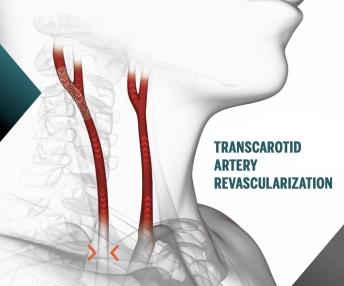Procedure reduces stroke risk during carotid artery surgery
- Category: Blog, Heart, Neuromedicine, News
- Posted On:
- Written By: King's Daughters Health
Stroke is the leading cause of disability, and the No. 5 cause of death, in the U.S. A stroke occurs when a blood vessel that carries oxygen and nutrients to the brain is either blocked (ischemic stroke) or ruptures (hemorrhagic stroke).
 Carotid artery disease causes more than half of all strokes in the U.S., according to the National Heart, Lung and Blood Institute. Carotid artery disease is caused by atherosclerosis, or a buildup of plaque on the inside walls of the arteries, similar to what occurs in heart disease. Plaque is made up of cholesterol, fat, calcium, cellular waste and proteins.
Carotid artery disease causes more than half of all strokes in the U.S., according to the National Heart, Lung and Blood Institute. Carotid artery disease is caused by atherosclerosis, or a buildup of plaque on the inside walls of the arteries, similar to what occurs in heart disease. Plaque is made up of cholesterol, fat, calcium, cellular waste and proteins.
In carotid artery disease, the arteries narrow and become rigid, reducing blood flow to the brain. Over time, plaque buildup can completely close the carotid artery, causing stroke.
The standard of care for opening blocked carotid arteries is a carotid endarterectomy, or CEA. During a CEA, the surgeon makes an incision in the neck area, opens the artery and removes any blockages.
A less invasive approach, transfemoral carotid artery stenting, is also available. In this approach, the physician works through a tube inserted into the artery in the upper thigh. A small, umbrella-like filter is placed beyond the diseased area of the carotid artery to help limit fragments of plaque from traveling toward the brain during the procedure. The physician then inserts a slender, metal-mesh tube, called a stent, which expands inside the carotid artery to increase blood flow to the brain and stabilize the plaque.
Both approaches are widely accepted and effective. However, patients who are elderly; have multiple health problems; had prior surgery in the neck area or heart; whose blockages are high in the neck; or those who received radiation treatment are often not candidates for these approaches.
A new procedure now available at King’s Daughters offers a hope for those previously unable to have this potentially life-saving procedure.
Trans-Carotid Artery Revascularization, or TCAR, combines the advantages of both surgeries, reduces risk of complications, and provides additional options to high-risk patients. King’s Daughters vascular/endovascular surgeon Omran Abul-Khoudoud, M.D., is the first physician in the Tri-State region to perform TCAR.
The entire TCAR procedure is performed through a smaller incision in the neck and in less than half the time of a carotid endarterectomy, thus limiting the stress on the heart and reducing the risk of the patient having a stroke or heart attack during the procedure.
During the procedure, a tube inserted into the carotid artery is connected to a system that temporarily directs blood flow away from the brain to protect against dangerous debris from reaching the brain. “This way, when we are crossing the blockage and treating it with the balloon and stent, we are not allowing any debris or plaque that has been loosened to travel to the brain and cause stroke,” Dr. Khoudoud noted.
The blood is filtered and returned to a vein in the groin. Just as in carotid stenting, a metal mesh stent is implanted to stabilize the area and prevent future stroke.
“Patients recover pretty quickly and most of the time they go home the next day,” Dr. Khoudoud said. They are able to return to a full and productive life with less pain and smaller scars than traditional treatments – with a reduced risk of future stroke.
The sole purpose of TCAR and CEA is to prevent stroke. More than 3,000 of the procedures have been performed worldwide and studies have shown excellent clinical data.
King’s Daughters is the only public hospital in the region offering the procedure, Dr. Khoudoud said. Previously, patients would have to travel to Cincinnati or Lexington for TCAR.

